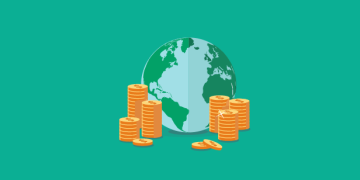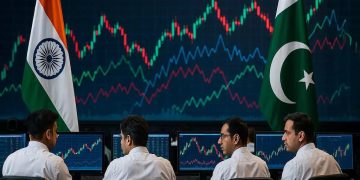1. A World Built on Code
The global economy of 2025 runs on silicon, data, and algorithms. The invisible architecture of the digital world—semiconductors, AI models, cloud infrastructure—has become the new foundation of national power. Once, oil determined the fate of nations; now, it’s data and chips.
This shift has created both prosperity and polarization. Artificial intelligence, automation, and digital platforms are driving new growth opportunities even as they redraw the boundaries between winners and losers.
The question confronting the world today is not whether technology will reshape the global economy—it already has—but who controls the tools, the talent, and the trust that define this new era.
According to the IMF’s 2025 Digital Competitiveness Index, countries that invested heavily in digital infrastructure during the early 2020s are now enjoying productivity gains 30–50% higher than global averages. But those left behind—particularly low-income nations—face what economists call the “tech gap trap”: falling further behind as each new innovation widens the distance.
2. From Industrial Capital to Digital Capital
Every industrial revolution redefines what nations value.
The 19th century was powered by coal and steel.
The 20th century by oil and manufacturing.
The 21st is defined by data and intelligence.
In 2025, the five largest publicly traded companies in the world—Microsoft, Apple, NVIDIA, Alphabet, and Amazon—together hold a combined market capitalization of over $12 trillion, exceeding the GDP of Japan and Germany combined.
Their dominance underscores a new reality: intangible capital—algorithms, data sets, user networks—is now more valuable than tangible assets.
This shift is transforming everything from how companies are valued to how governments compete. Nations are no longer racing to build factories; they’re racing to build ecosystems—AI research hubs, semiconductor fabs, quantum labs, and digital innovation zones.
As economist Mariana Mazzucato puts it: “The state is no longer just a regulator—it’s an architect of digital ambition.”
3. The AI Revolution and the Productivity Paradox
AI has become the most powerful technological general-purpose innovation since electricity.
The OECD’s 2025 Productivity Review notes that countries integrating AI into production have seen labor productivity rise between 1.5 and 2.3 percentage points annually. Yet paradoxically, global growth remains subdued—hovering around 3.1% according to the IMF.
Economists call this the “AI productivity paradox”: the technology’s potential is enormous, but the benefits are unevenly distributed and slow to diffuse.
In advanced economies, AI has boosted sectors like logistics, healthcare analytics, and digital design. In emerging markets, however, adoption is constrained by data scarcity, energy costs, and skills shortages.
The World Bank estimates that by 2027, nearly 40% of global labor tasks will be automatable—but only 15% of firms in developing economies will have the infrastructure to capitalize on that shift.
Thus, instead of a global productivity boom, AI risks deepening inequality—creating what one McKinsey report calls “a two-speed world”: hyper-productive digital economies, and analog economies struggling to catch up.
4. Silicon as the New Oil
If AI is the engine of the digital age, semiconductors are its fuel.
And like oil in the 20th century, chips have become geopolitically charged.
The semiconductor supply chain—stretching from design labs in California to fabrication plants in Taiwan and testing hubs in Malaysia—represents one of the most complex networks in human history. A single advanced chip may pass through 20 countries before reaching its final destination.
Yet this delicate ecosystem is under strain. Export controls, trade restrictions, and subsidies are fragmenting what was once a unified global industry.
The U.S. CHIPS and Science Act, the EU Chips Act, and China’s Integrated Circuit Plan have unleashed hundreds of billions in public funding, each seeking to localize production.
But full “chip sovereignty” remains elusive. Advanced lithography machines, for example, are still dominated by ASML in the Netherlands; high-end materials rely on Japanese suppliers; and assembly remains concentrated in Asia.
The result is a techno-geopolitical chessboard—a global contest where every node of the chip supply chain has strategic value.
5. Digital Protectionism and the Fragmentation of the Internet
Beyond hardware, the digital realm itself is splintering.
The dream of a single, open internet—once heralded as globalization’s greatest triumph—is fading into a patchwork of digital sovereignties.
The EU’s Digital Markets Act (DMA) and AI Act are rewriting the rules for data privacy, algorithmic transparency, and platform regulation.
China continues to enforce its Cybersecurity and Data Security Laws, emphasizing control and national oversight.
The United States, for its part, promotes innovation but grapples with questions of misinformation, monopoly power, and ethical AI.
What emerges is a “balkanized internet”—not divided by technology, but by governance.
Cross-border data flows now require compliance with multiple regimes, forcing companies to operate within “digital borders.”
The OECD estimates that compliance costs for multinational tech firms have risen by 35% since 2020 due to regulatory divergence.
The internet, once a borderless commons, is evolving into a network of controlled gateways—each shaped by cultural, political, and economic priorities.
6. The Labor Divide: Humans and Machines
The AI era has reignited an ancient fear: that machines might replace people.
While automation is not new, the scope and speed of today’s technological change are unprecedented.
A 2025 ILO report finds that up to 300 million jobs globally could be disrupted by AI-driven automation by 2030. Yet history suggests that while technology destroys some jobs, it also creates new ones—in areas like data labeling, prompt engineering, and human-AI coordination.
The challenge lies in transition. Workers displaced from low-skill manufacturing or administrative roles often lack the training to shift into digital or analytical work.
Countries investing in reskilling ecosystems—like Singapore, South Korea, and the Nordics—are cushioning the shock. Others risk seeing inequality and unemployment rise in parallel with productivity.
AI doesn’t eliminate work; it redefines it. The defining policy question of the 2020s is whether societies can adapt fast enough to absorb that redefinition.

7. Emerging Markets and the Digital Leap
Not all developing countries are falling behind.
Some are leapfrogging directly into the digital age.
India’s Digital Public Infrastructure (DPI)—which integrates ID, payments, and data sharing—has become a model for inclusive digital growth.
Kenya’s M-Pesa ecosystem remains a benchmark for fintech innovation.
Vietnam and Indonesia are building competitive digital manufacturing clusters that blend low-cost labor with smart automation.
According to the World Economic Forum, digital trade from emerging Asia now accounts for nearly 25% of global e-commerce flows—a remarkable rise from less than 10% a decade ago.
Still, challenges persist: data localization, energy constraints, cybersecurity vulnerabilities, and limited AI research capacity. The divide, then, is not merely technological—it’s institutional. The nations that combine infrastructure with governance will define the next digital wave.
8. The Green-Tech Convergence
The climate transition and the digital revolution are increasingly intertwined.
Smart grids, carbon accounting AI, autonomous energy systems—these are the building blocks of a sustainable economy.
In 2025, global investment in “green-tech” surpassed $1.8 trillion, led by renewables, battery innovation, and smart mobility.
AI and big data are being used to optimize resource allocation, forecast weather extremes, and design low-emission cities.
Yet green innovation also fuels new dependencies. Clean technologies rely on critical minerals—lithium, cobalt, nickel—often sourced from geopolitically sensitive regions.
This has given rise to what some call “resource-tech diplomacy”: partnerships between resource-rich nations and technology powers to secure access and share knowledge.
In this sense, climate action is no longer purely environmental—it’s strategic industrial policy.
9. Digital Inequality and the New Global Divide
Even as technology lifts productivity, it is entrenching inequality—between nations, regions, and social groups.
The top 10% of countries by digital readiness capture nearly 90% of AI-related investment.
Within nations, highly skilled workers benefit from rising demand and wages, while routine workers face stagnation.
The UN Development Programme warns of a growing “digital apartheid”: a world divided not just by income, but by connectivity and algorithmic access.
If unchecked, this divide could deepen political polarization and social unrest, eroding trust in the very technologies designed to empower.
To bridge this gap, global cooperation on digital education, open-source tools, and ethical AI standards will be essential.
But as geopolitical rivalry intensifies, such cooperation remains elusive.
10. What Comes Next: The Digital Bretton Woods
The world’s digital infrastructure is now as critical as its physical one.
Just as the Bretton Woods system in 1944 established rules for global finance, many economists argue that the 2020s need a Digital Bretton Woods—a framework for data flows, AI governance, and cyber stability.
International bodies are beginning to respond.
The OECD, UNESCO, and World Economic Forum are working on AI ethics standards.
Regional blocs like ASEAN and the African Union are developing digital integration pacts.
But without binding global coordination, digital fragmentation may persist—limiting innovation and raising costs for everyone.
Ultimately, technology will continue to be both a tool and a test: a tool for prosperity, and a test of governance.
11. Conclusion: Competing Futures
The 2020s are not merely a race for innovation—they are a struggle over the meaning of progress itself.
Will technology deepen inequality or democratize opportunity?
Will nations use AI as a weapon of control or an engine of collaboration?
The answers will shape the next phase of globalization.
If the first digital revolution connected the world, the second must find a way to stabilize it.
Because in a world where code defines power, the true measure of progress will not be how smart our machines become—but how wisely we use them.
































